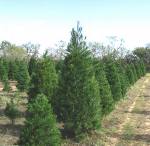Poverty Pine Tree Information
Images of Poverty Pine:






Poverty Pine grows in the following 17 states and provinces:
Alabama, Delaware, Georgia, Indiana, Kentucky, Maryland, Mississippi, New Jersey, New York, North Carolina, Ohio, Oklahoma, Pennsylvania, South Carolina, Tennessee, Virginia, West VirginiaInformation about Poverty Pine:
The Pinus Virginiana is commonly known as the Jersey Pine, Oldfield Pine, Possum Pine, Poverty Pine, Scrub Pine, Shortstraw Pine, Spruce Pine as well as Virginia Pine.
The currently accepted name of Virginia pine is Pinus virginiana Mill. There are no accepted subspecies, varieties, or forms .The native range of Virginia pine extends from southern New Jersey west to Pennsylvania and southern Ohio; south to South Carolina, northern Georgia, northern Alabama, and northern Mississippi . It has also been planted in east-central Oklahoma .Virginia pine can occur in pure stands or as a member of mixed pine-hardwood communities, particularly those with oak (Quercus spp.) . It is associated with pitch pine (P. rigida) and Table Mountain pine (P. pungens) in the Appalachian Mountains. On the eastern shores of Virginia and Maryland it is associated with loblolly pine (Pinus taeda) and sweetgum (Liquidambar styraciflua). In the Peidmont region it is associated with shortleaf pine (P. echinata) and oaks . Published classifications that include Virginia pine as a dominant or codominant species include the following: Classification and evaluation of forest sites in the Cumberland Mountains Classification and evaluation of forest sites on the northern Cumberland Plateau Classification and evaluation of forest sites on the Natchez Trace State Forest Southeastern evergreen and oak-pine region Landscape ecosystem classification for South Carolina Some of the information provided here is attributed to:Sullivan, Janet. 1993. Pinus virginiana. In: Fire Effects Information System, [Online]. U.S. Department of Agriculture, Forest Service, Rocky Mountain Research Station, Fire Sciences Laboratory (Producer). , available at the USDA Fire Effects Information System (FEIS) website